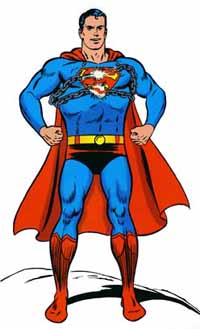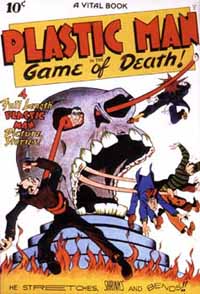|
|
|
Ranking the five greatest comic-book superheroes November 7, 2002 By Franklin Harris Who is the greatest comic-book superhero of all? Most people say Superman. After all, he is the best known superhero. But on my list, the Man of Steel comes in at No. 5, which is a good place to start my countdown.
Given all of that, there must be a good reason why I don't rank Superman higher. There is. Superman is boring. While Superman was a popular character in the 1940s he didn't hit his stride until the '60s. It was then that Superman became the character we know today, with his Fortress of Solitude and outlandish adversaries. (In the '40s, Lex Luthor was Superman's only memorable foe.) But in the mid '80s, DC Comics stripped away most of what made the '60s Superman interesting. This "back to basics" approach amounted to "back to boring." And recent attempts to resurrect some of Superman's Silver Age glory have foundered. The damage is hard to undo. For some of Superman's finest moments, see the trade paperback collection "Superman in the '60s." The reason for Plastic Man's greatness is one man, Jack Cole. Cole was probably the best cartoonist of the Golden Age, and under his guidance, Plastic Man became the first surreal superhero. Pulitzer Prize-winning cartoonist Art Spiegelman writes, "Jack Cole's 'Plastic Man' belongs high on any adult's How to Avoid Prozac list, up there with the best of S.J. Perelman, Laurel and Hardy, Damon Runyan, Tex Avery and the Marx Brothers." For the best of Plastic Man, see Spiegelman and Chip Kidd's "Jack Cole and Plastic Man: Forms Stretched to Their Limits" and the four volumes of DC Comics' "Plastic Man Archives." Plastic Man also is showcased in the recent "JLA" No. 65. Spider-Man's alter ego, Peter Parker, started out as a high-school nerd with no love life and money problems. Today, he is a high-school science teacher with a messed-up love life and money problems. But he still dons his red-and-blue tights to fight the likes of the Green Goblin and Doctor Octopus. Why? Because "with great power comes great responsibility." Often derided as a Superman clone, Captain Marvel is anything but. First, Captain Marvel has a unique secret identity. He is really Billy Batson, a boy who becomes the World's Mightiest Mortal by saying the magic word "Shazam!"
Third, Captain Marvel benefited from the talents of the best creators of the Golden Age, including artist C.C. Beck. Readers during the '40s agreed. "Captain Marvel" and "Whiz Comics," both starring Captain Marvel, outsold "Superman" and "Action Comics." For the best of Captain Marvel's adventures, see the three volumes of "Shazam! Archives," published by DC Comics. To learn what makes Batman the best, see Frank Miller's graphic novel, "Batman: The Dark Knight Returns" (not "The Dark Knight Strikes Again") and the trade paperback collection "Batman in the '70s." |

RECENT COLUMNS
Order a helping of Cartoon Network's 'Robot Chicken'
03/31/05
Campaign against video games is political grandstanding
03/24/05
Prize-winning author is 'Wrong About Japan'
03/17/05
Censored book not a good start
03/10/05
Some superhero comics are for 'fanboys' only
03/03/05
'Constantine' does well with its out-of-place hero
02/24/05
'80s publisher First Comics' legacy still felt
02/17/05
Director's cut gives new 'Daredevil' DVD an edge
02/10/05
Put the fun back into 'funnybooks'
02/04/05
Is 'Elektra' the end of the road for Marvel movies?
01/27/05
'House of Flying Daggers' combines martial arts and heart
01/20/05
Anniversary edition of 'Flying Guillotine' has the chops
01/13/05
Movie books still have role in the Internet era
01/06/05
Looking ahead to the good and the bad for 2005
12/30/04
The best and worst of 2004
12/23/04
'Has-been' Shatner is a 'transformed man'
12/16/04
© Copyright 2005 PULP CULTURE PRODUCTIONS
Web site designed by Franklin Harris.
Send feedback to franklin@pulpculture.net.
 Superman was the first "total package." He had the spandex costume, the secret identity and abilities far beyond those of mortal men.
Superman was the first "total package." He had the spandex costume, the secret identity and abilities far beyond those of mortal men.
 Second, from the beginning, Captain Marvel had a strong supporting cast of villains and sidekicks, something Superman wouldn't have until the '60s.
Second, from the beginning, Captain Marvel had a strong supporting cast of villains and sidekicks, something Superman wouldn't have until the '60s.